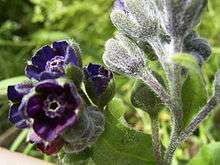Cynoglossum
| Cynoglossum | |
|---|---|
 | |
| Cynoglossum officinale | |
| Scientific classification | |
| Kingdom: | Plantae |
| (unranked): | Angiosperms |
| (unranked): | Eudicots |
| (unranked): | Asterids |
| Order: | Boraginales |
| Family: | Boraginaceae |
| Subfamily: | Boraginoideae |
| Tribe: | Cynoglosseae |
| Genus: | Cynoglossum L. |
| Type species | |
| Cynoglossum officinale | |
| Species | |
|
See text. | |
There are many species in the plant genus Cynoglossum (/ˌsɪnoʊˈɡlɒsəm, ˌsaɪ-, -nə-/[1][2]). They are coarse-appearing, small-flowered plants of the family Boraginaceae. Cynoglossum officinale, the common hound's-tongue, is a native of Asia, Africa, and Europe. It has been introduced into North America, and it is considered to be a troublesome weed because its burs stick to the wool of sheep and to other animals. Ingestion of this plant can also lead to photosensitivity in grazing animals.
Cynoglossum virginianum, known as Wild comfrey, is a common plant from New York to Florida. Cynoglossum boreale occurs in the northern United States as far west as Minnesota and in Canada.
Cynoglossum amabile, known as Chinese Forget-me-not and Chinese Hound's Tongue, originally a wildflower from Southwest China, is now found in Europe and North America.
Cynoglossum blue are also known as Forget-me-nots.[3]
"Cynoglossom Grande" is native to California.
In Iran there are 3 species of this plant from which Cynoglossum tehranicum is only found in Iran.[4]
Selected species
- Cynoglossum amabile - Chinese hound's tongue, Chinese forget-me-not
- Cynoglossum apenninum
- Cynoglossum australe - Australian hound's tongue
- Cynoglossum boreale - northern wild comfrey
- Cynoglossum castellanum
- Cynoglossum cheirifolium
- Cynoglossum clandestinum
- Cynoglossum columnae
- Cynoglossum creticum - blue hound's tongue
- Cynoglossum dioscoridis
- Cynoglossum furcatum - Indian hound's tongue
- Cynoglossum germanicum - green hound's tongue
- Cynoglossum glochidiatum - prickly hound's tongue
- Cynoglossum grande - Pacific hound's tongue
- Cynoglossum hungaricum
- Cynoglossum magellense
- Cynoglossum microglochin - smallbristle hound's tongue
- Cynoglossum nervosum - hairy hound's tongue
- Cynoglossum occidentale - western hound's tongue
- Cynoglossum officinale - common hound's tongue, gypsyflower
- Cynoglossum reverchonii
- Cynoglossum rotatum
- Cynoglossum sphacioticum h. riedl.
- Cynoglossum suaveolens - sweet hound's-tongue[5]
- Cynoglossum tehranicum = Cynoglossum montanum = Cynoglossum nebrodense - mountain hound's tongue.[4]
- Cynoglossum troodi - Troodos hound's tongue
- Cynoglossum virginianum - wild comfrey
- Cynoglossum zeylanicum - Ceylon hound's tongue
References
- ↑ Sunset Western Garden Book, 1995:606–607
- ↑ "Pronunciation Guide for Plants". Retrieved 2016-01-23.
- ↑ Lowe's package.
- 1 2 Mozaffarian, V. 1996. A dictionary of Iranian plant names: Latin, English, Persian. Tehran: Farhang-e Moʻaser.
- ↑ "Cynoglossum". Australian Plant Name Index (APNI), IBIS database. Centre for Plant Biodiversity Research, Australian Government, Canberra. Retrieved 2008-11-26.